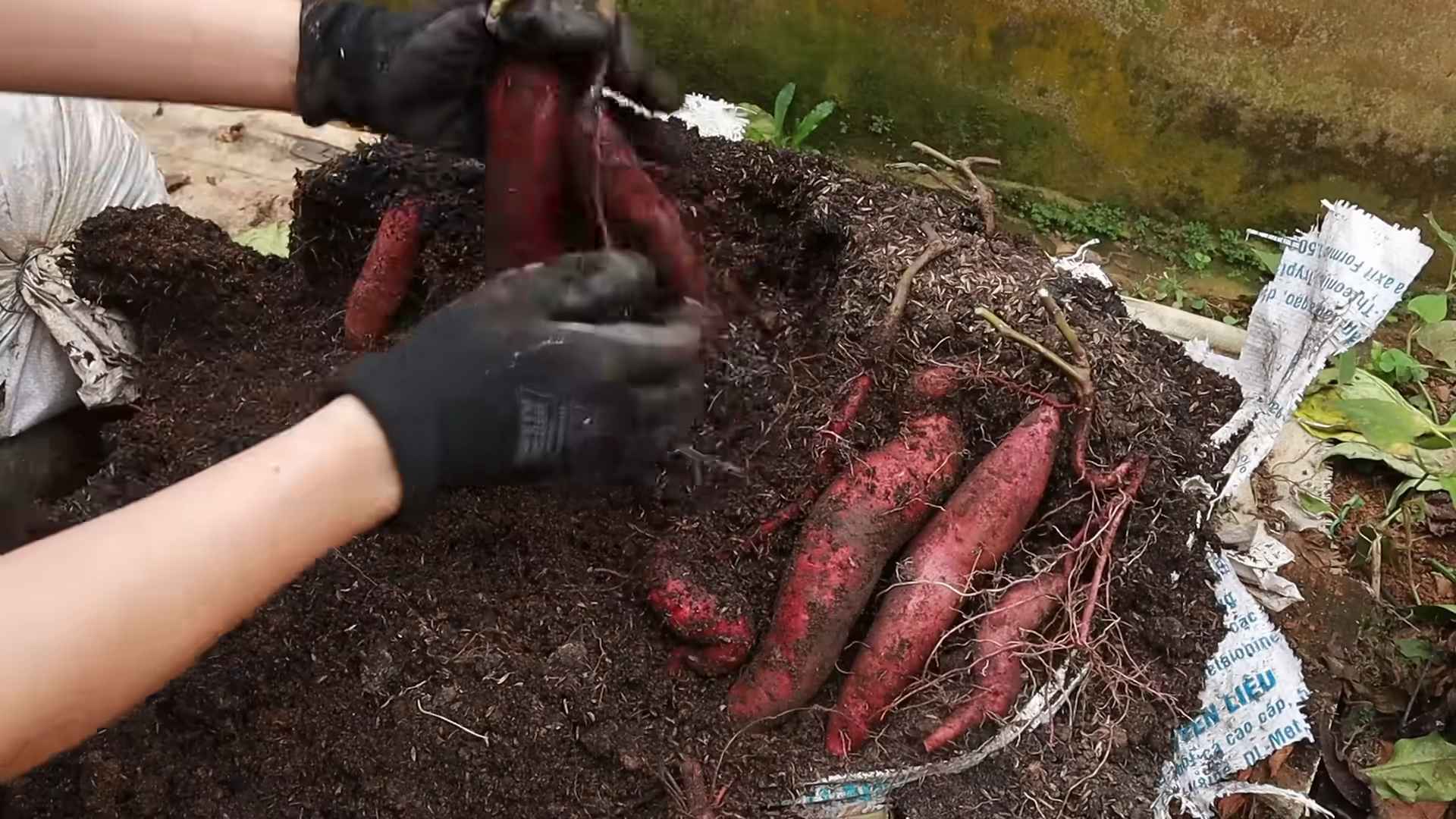Sweet Potato Terrace Gardening: Grow Your Own Delicious Harvest in Small Spaces
Sweet potato terrace gardening—it sounds a bit fancy, doesn’t it? But trust me, it’s easier than you think! I’ve always loved the taste of homegrown sweet potatoes, that earthy sweetness you just can’t replicate with store-bought ones. But for years, I thought growing them was limited to sprawling farms. Then I discovered the magic of terrace gardening, and my world (and my taste buds!) changed.
The history of sweet potatoes is fascinating, stretching back centuries to Central and South America. These nutritious tubers have played a vital role in various cultures, providing sustenance and becoming a staple in many cuisines. Now, you can experience the joy of growing your own, even if you only have a small balcony or patio. This isn’t just about delicious sweet potatoes; it’s about connecting with nature and enjoying the satisfaction of nurturing your own food.
Why Terrace Gardening for Sweet Potatoes?
Many people believe that growing sweet potatoes requires a large plot of land, but sweet potato terrace gardening proves that wrong! This method is perfect for those with limited space, like apartment dwellers or those with small yards. It maximizes vertical space, allowing you to grow a bountiful harvest even in a confined area. Plus, it’s a fantastic way to add a touch of green to your urban landscape. You’ll be amazed at how much you can grow using this simple yet effective technique.
In this article, I’ll share my tried-and-true sweet potato terrace gardening tips and tricks, from choosing the right variety to harvesting your delicious crop. Get ready to transform your terrace into a thriving sweet potato patch—it’s easier and more rewarding than you might imagine!

Building Your Sweet Potato Terrace Garden: A Step-by-Step Guide
I love sweet potatoes, and I’ve found that terrace gardening is a fantastic way to grow them, even if you don’t have a huge yard. This guide will walk you through building your own sweet potato terrace garden, from planning to harvest. Let’s get started!
Phase 1: Planning and Preparation
- Choose your location: Select a sunny spot on your terrace that receives at least six to eight hours of direct sunlight daily. Sweet potatoes need plenty of sun to thrive.
- Assess your space: Measure the available space on your terrace to determine the size of your garden. This will help you decide how many sweet potato plants you can comfortably accommodate.
- Gather your materials: You’ll need several things for this project. I’ll list them below, but feel free to adapt based on what you have available. Remember, this is a DIY project, so creativity is key!
Here’s a list of materials you’ll need:
- Large containers (at least 12 inches deep and wide; I prefer repurposed plastic storage containers or large, sturdy planters. The deeper, the better!)
- Well-draining potting mix (avoid using garden soil directly, as it can be too heavy and compact for sweet potatoes).
- Sweet potato slips (these are small sprouts that grow from a sweet potato; you can buy these from nurseries or even sprout your own from a sweet potato – more on that later!).
- Gardening gloves
- Watering can or hose
- Optional: Trellis or stakes for support (sweet potato vines can get quite long!)
- Optional: Organic fertilizer (a balanced fertilizer is ideal)
Phase 2: Preparing the Containers and Planting
- Prepare your containers: If using repurposed containers, make sure they are clean and free of any debris. Drill drainage holes in the bottom of each container if they don’t already have them. This is crucial for preventing root rot.
- Fill the containers: Fill each container about ¾ full with your well-draining potting mix. Leave some space at the top for watering.
- Plant the slips: Gently place your sweet potato slips into the potting mix, burying them about 2-3 inches deep. Space them appropriately according to the size of your container and the mature size of the sweet potato variety you’ve chosen. Allow for adequate space between plants for growth.
- Water thoroughly: After planting, water the soil gently but thoroughly, ensuring the entire root ball is moistened. Don’t overwater, though; you want the soil to be moist, not soggy.
- Add support (optional): If you’re using a trellis or stakes, install them now to provide support for the growing vines. This will prevent them from sprawling and becoming tangled.
- Fertilize (optional): After a couple of weeks, you can lightly fertilize your plants with a balanced organic fertilizer. Follow the instructions on the fertilizer packaging carefully.
Phase 3: Ongoing Care and Maintenance
- Watering: Water regularly, keeping the soil consistently moist but not waterlogged. The frequency of watering will depend on the weather and the type of container you are using. Check the soil moisture regularly by sticking your finger a couple of inches into the soil. If it feels dry, it’s time to water.
- Weeding: Regularly remove any weeds that may sprout in your containers. Weeds compete with your sweet potato plants for nutrients and water.
- Pest and disease control: Keep an eye out for any signs of pests or diseases. Address any issues promptly using organic pest control methods if necessary. Prevention is key; ensure good air circulation around your plants.
- Monitoring growth: Observe your plants regularly. If you notice any issues, such as yellowing leaves or stunted growth, investigate the cause and take corrective action. This might involve adjusting watering, fertilization, or addressing pest problems.
- Harvesting: Sweet potatoes are typically ready for harvest about three to four months after planting, depending on the variety and growing conditions. The leaves will start to yellow and die back as the tubers mature. Gently lift the plants from the containers to harvest the sweet potatoes. Be careful not to damage the tubers.
Phase 4: Sprouting Your Own Sweet Potato Slips (Optional)
If you want to save money and have more control over your plants, you can sprout your own slips. Here’s how:
- Select a sweet potato: Choose a healthy, organic sweet potato that’s free of blemishes. Avoid using sweet potatoes that have been treated with growth inhibitors.
- Prepare the sweet potato: Wash the sweet potato thoroughly and pat it dry. You can leave the skin on.
- Planting the sweet potato: Place the sweet potato in a shallow dish or container filled with water. Ensure that about one-third of the sweet potato is submerged in the water. Change the water every few days to prevent bacterial growth.
- Sprout development: Within a few weeks, you should see small sprouts emerging from the “eyes” of the sweet potato. These are your slips.
- Planting the slips: Once the slips are a few inches long, you can carefully separate them from the sweet potato and plant them in your prepared containers as described in Phase 2.
Remember, patience is key! Sweet potato gardening takes time and effort, but the reward of harvesting your own delicious sweet potatoes is well worth it. Happy gardening!

Conclusion
So there you have it – a complete guide to achieving bountiful harvests with your very own sweet potato terrace garden! This DIY trick isn’t just about growing sweet potatoes; it’s about reclaiming space, maximizing yield, and experiencing the unparalleled satisfaction of nurturing your food from seed to plate. Sweet potato terrace gardening offers a unique blend of practicality and aesthetic appeal, transforming even the smallest urban spaces into thriving edible landscapes. The ease of setup, minimal maintenance, and impressive results make this method a game-changer for both seasoned gardeners and enthusiastic beginners alike. Forget the limitations of traditional gardening – with this technique, you can cultivate a vibrant sweet potato patch regardless of your available land.
The beauty of this method lies in its adaptability. Experiment with different varieties of sweet potatoes to discover your favorites. Consider incorporating companion plants like basil or marigolds to deter pests and enhance the overall health of your garden. You can also adjust the size and structure of your terrace garden to suit your specific needs and available space. Perhaps you’ll create a tiered system for even greater yield, or integrate it seamlessly into your existing patio décor. The possibilities are truly endless!
Beyond the practical benefits, sweet potato terrace gardening offers a rewarding connection to nature. The process of nurturing these plants from slips to mature vines, watching them flourish and ultimately providing you with a delicious harvest, is deeply satisfying. It’s a journey of growth, both for the plants and for yourself. It’s a chance to connect with the earth, learn about sustainable practices, and enjoy the fruits (or rather, the sweet potatoes!) of your labor.
We strongly encourage you to try this amazing sweet potato terrace gardening technique. Share your experiences, photos, and tips with us and the wider gardening community. Let’s inspire each other to cultivate more food, more beauty, and more connection to the natural world. Your success story could be the next inspiration for someone else to embark on their own sweet potato gardening adventure. Don’t hesitate – start planning your terrace garden today and get ready to enjoy the sweetest rewards!
Frequently Asked Questions
What type of sweet potato slips should I use?
Using healthy, disease-free slips is crucial for a successful harvest. Look for slips that are firm, vibrant green, and free from any signs of damage or disease. You can purchase slips from reputable nurseries or even propagate your own from existing sweet potatoes. Ensure they are at least 6-8 inches long for optimal growth.
How much sunlight do sweet potatoes need?
Sweet potatoes thrive in full sun, meaning at least 6-8 hours of direct sunlight per day. Choose a location for your terrace garden that receives ample sunlight throughout the growing season. If your terrace is partially shaded, you may need to supplement with grow lights to ensure adequate sunlight exposure.
What kind of soil is best for sweet potato terrace gardening?
Well-draining soil is essential for sweet potatoes to prevent root rot. A sandy loam soil mix is ideal. You can amend your soil with compost or other organic matter to improve drainage and fertility. Avoid heavy clay soils, which retain too much moisture.
How often should I water my sweet potatoes?
Water your sweet potatoes regularly, especially during dry periods. Aim for consistently moist soil, but avoid overwatering, which can lead to root rot. Check the soil moisture regularly by sticking your finger a couple of inches into the soil. Water when the top inch or two feels dry.
When can I harvest my sweet potatoes?
Sweet potatoes are typically ready for harvest 3-4 months after planting, depending on the variety and growing conditions. The vines will start to die back, and the leaves will turn yellow or brown, indicating that it’s time to harvest. Gently dig up the potatoes, being careful not to damage them.
What are some common problems I might encounter?
Common problems include pests like sweet potato weevils and diseases like root rot. Regularly inspect your plants for signs of pests or diseases. Use appropriate pest control methods and ensure good drainage to prevent root rot. Proper spacing and air circulation can also help prevent disease.
Can I grow sweet potatoes in containers on my terrace?
Absolutely! Sweet potatoes grow well in containers, making them perfect for terrace gardening. Choose large containers with ample drainage holes to prevent waterlogging. Ensure the containers are at least 12-18 inches deep to accommodate the root system.
What if I don’t have a lot of space on my terrace?
Even a small terrace can accommodate a sweet potato garden. Consider using vertical gardening techniques, such as hanging baskets or trellises, to maximize space. You can also choose compact sweet potato varieties that require less space.
Can I use this method in different climates?
This method is adaptable to various climates, but sweet potatoes require a warm climate with long, frost-free growing seasons. Adjust your planting time and consider using protective measures like row covers if you live in a cooler climate. Always check the specific requirements of the sweet potato variety you choose.
Where can I find more information on sweet potato terrace gardening?
Numerous online resources, gardening books, and local agricultural extension offices can provide additional information on sweet potato cultivation and terrace gardening techniques. Don’t hesitate to seek advice from experienced gardeners in your area.




Leave a Comment